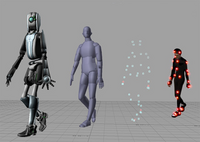
Photo from wikipedia
In this paper, we present a hybrid mathematical model describing crowd dynamics. More specifically, our approach is based on the well-established Helbing-like discrete model, where each pedestrian is individually represented… Click to show full abstract
In this paper, we present a hybrid mathematical model describing crowd dynamics. More specifically, our approach is based on the well-established Helbing-like discrete model, where each pedestrian is individually represented as a dimensionless point and set to move in order to reach a target destination, with deviations deriving from both physical and social forces. In particular, physical forces account for interpersonal collisions, whereas social components include the individual desire to remain sufficiently far from other walkers (the so-called territorial effect). In this respect, the repulsive behaviour of pedestrians is here set to be different from traditional Helbing-like methods, as it is assumed to be largely determined by how they perceive the presence and the position of neighbouring individuals, i.e. either objectively as pointwise/localized entities or subjectively as spatially distributed masses. The resulting modelling environment is then applied to specific scenarios, that first reproduce a real-world experiment, specifically designed to derive our model hypothesis. Sets of numerical realizations are also run to analyse in more details the pedestrian paths resulting from different types of perception of small groups of static individuals. Finally, analytical investigations formalize and validate from a mathematical point of view selected simulation outcomes.
Journal Title: Royal Society Open Science
Year Published: 2017
Link to full text (if available)
Share on Social Media: Sign Up to like & get
recommendations!